Here are all comparative quote images from this site’s articles. They juxtapose Eckhart Tolle’s words with those of earlier authors, mainly Maurice Nicoll, expressing corresponding ideas in similar ways. Use the forward and back arrows near the top corners of the images to cycle through them. Each set of quotes has a caption underneath with further information. To browse quotes by category, use the links at the bottom of the page.
Quotes on Self-Observation
These images come from an article series comparing how Nicoll and Tolle present the practice of self-observation.

We mistake the false self for who we are, the authors say, but when we observe or recognize what’s in us clearly, our illusory/imaginary self begins to dissolve.
Read the article this image was featured in here.
The illusory or imaginary “I” or identity we cling to, and its fictitious self-image/pictures, will start to dissolve or collapse when brought into the light of consciousness, the authors say.
Read the article this image was featured in here.
Nicoll and Tolle both explain that a person can discover the truth of who they are only by gradually identifying what they are not.
Read the article this image was featured in here.
They describe how, after observing themselves, a person might laugh at the thoughts and emotions they see and how ridiculous they are.
Read the article this image was featured in here.
Nicoll and Tolle both direct readers to observe how negativity drains one’s force / vital energy.
Read the article this image was featured in here.
They both describe how an immediate physical threat can trigger an instinctive fear reaction – something humans and animals have in common. Both also describe the fear producing physical sensations, such as muscle contraction, and a fight-or-flight response.
Read the article this image was featured in here.
Nicoll and Tolle both emphasize the need to observe the mechanical nature of the psyche in order to achieve inner freedom from external circumstances / conditions.
Read the article this image was featured in here.
Both Nicoll and Tolle refer to the parable of Jesus about seeing a mote in your brother’s eye but not the beam in your own eye as an example of the importance of observing yourself instead of criticizing others.
Read the article this image was featured in here.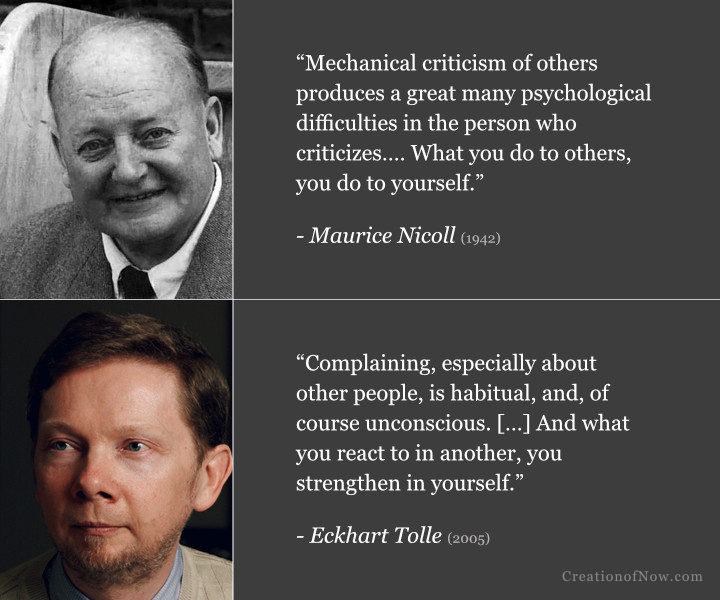
They emphasize that by criticizing other people, we strengthen faults and inner obstacles to spiritual progress.
Read the article this image was featured in here.
Using the example of bad weather, both authors explain how people fail to distinguish between external situations (which are neutral / impersonal) and the subjective internal reactions to those situations.
Read the article this image was featured in here.
Nicoll and Tolle both emphasize a distinction between the external events of life and a person’s internal reaction to that event.
Read the article this image was featured in here.
Both write that our inner life or state attracts the circumstances of our outer life.
Read the article this image was featured in here.
Both Nicoll and Tolle explain that the inner reality of the psyche is more “real” or primary for an individual than the outer, physical reality.
Read the article this image was featured in here.
Both authors describe how negativity accumulates over time beneath the surface, which can cause disproportionate emotional responses to external irritants or challenges.
Read the article this image was featured in here.
It takes sincerity or honesty to recognise any negativity directed towards others in our thoughts and feelings, they tell us.
Read the article this image was featured in here.
Persistent negative trains of thought can be fueled by feeling unfairly treated by others or even God, they tell us.
Read the article this image was featured in here.
Nicoll and Tolle both describe how grievances are often expressed inwardly as inner talking / compulsive thinking.
Read the article this image was featured in here.
They maintain that a lack of inner responsibility creates unhappiness in the world.
Read the article this image was featured in here.
Both indicate the importance of taking responsibility for your inner state at any moment.
Read the article this image was featured in here.
Nicoll and Tolle emphasise taking responsibility for your inner psychological world / inner space.
Read the article this image was featured in here.
They indicate being more conscious of our inner state gives us a choice in the moment.
Read the article this image was featured in here.
Both authors suggest that observing or seeing within brings the “power of choice.”
Read the article this image was featured in here.
The light of consciousness/presence is often designated as the agent of inner change.
Read the article this image was featured in here.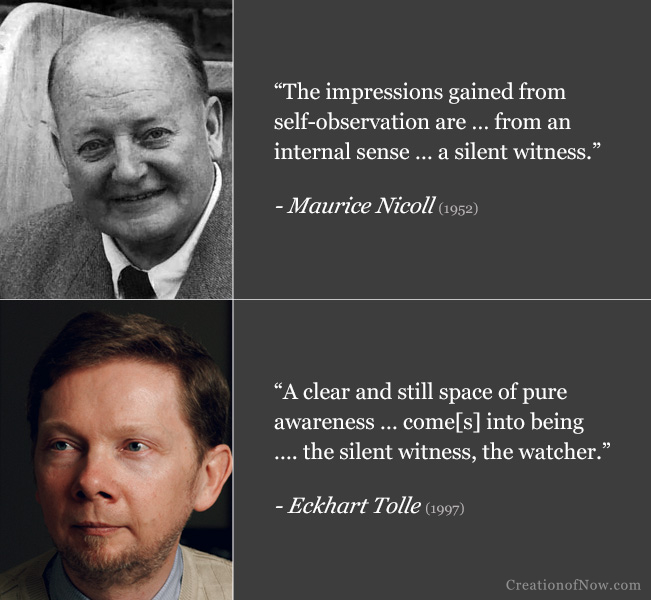
Both Nicoll and Tolle use the phrase “silent witness” to describe the inner sense of observation.
Read the article this image was featured in here.
We’re advised to observe what is within us without any criticism, analysis, or judgement toward ourselves or what we see.
Read the article this image was featured in here.
To prompt us to practice self-observation, Nicoll and Tolle suggest that we should pose questions to ourselves about our current psychological state.
Read the article this image was featured in here.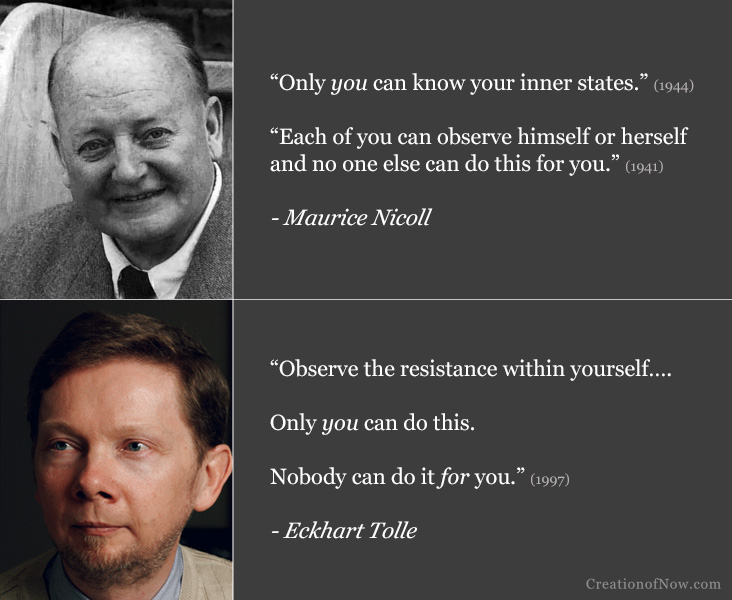
They emphasise that it’s up to you to observe your own inner states and no one else can do it for you.
Read the article this image was featured in here.
Nicoll and Tolle both encourage readers to make what is unconscious conscious through self-observation.
Read the article this image was featured in here.
The phrase “make it conscious” is used in connection with the self-observation process in the work of both Nicoll and Tolle.
Read the article this image was featured in here.
Bringing negative states into the light of consciousness by observation/attention is said to change or transform them.
Read the article this image was featured in here.
Nicoll and Tolle both state that the fire, flame, or light of consciousness is said to grow brighter as it burns up psychological pain and suffering.
Read the article this image was featured in here.
Any unconscious factors are said to lose their power when brought into the light of consciousnesses.
Read the article this image was featured in here.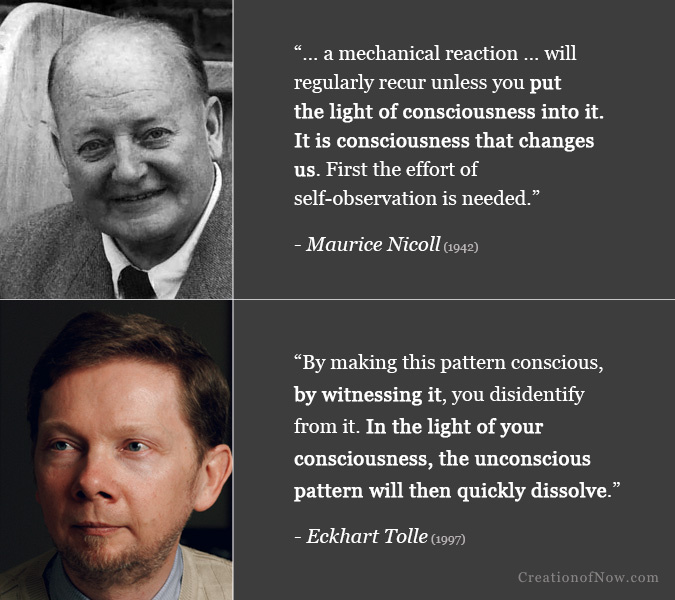
Nicoll and Tolle often describe the transformative effects “the light of consciousness” has on unconscious reactions/patterns. This “light” must be directed within via self-observation.
Read the article this image was featured in here.
By becoming identified with emotional reactions to life, people “become” their reactions, they explain.
Read the article this image was featured in here.
Compulsive thoughts are similarly described as old “gramophone records” playing in one’s head that sound like the monologues of people “muttering to themselves” in the street, only not expressed outwardly. This negative thinking is said to drain energy, according to Nicoll and Tolle, and they encourage readers to observe it in order to stop identifying with it.
Read the article this image was featured in here.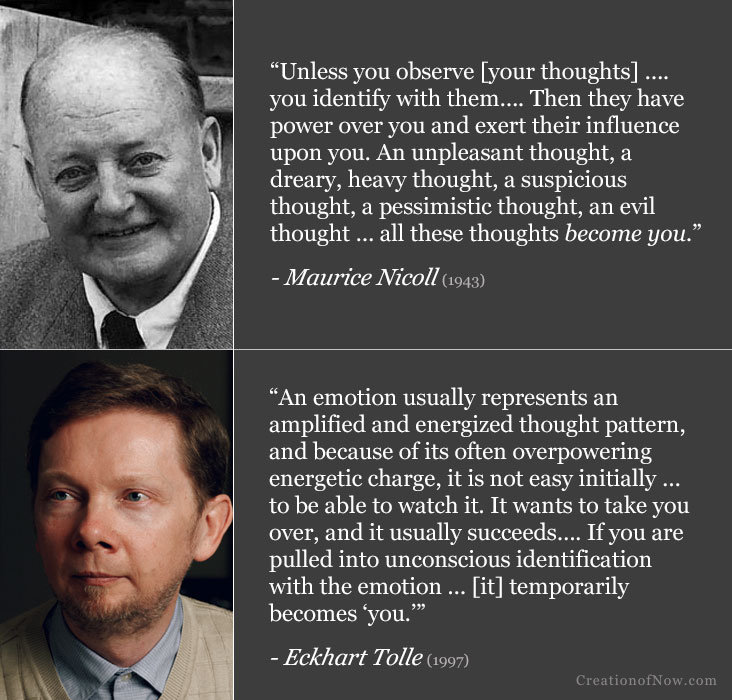
Nicoll and Tolle describe how thoughts and emotions can “become you” through a process called identification.
Read the article this image was featured in here.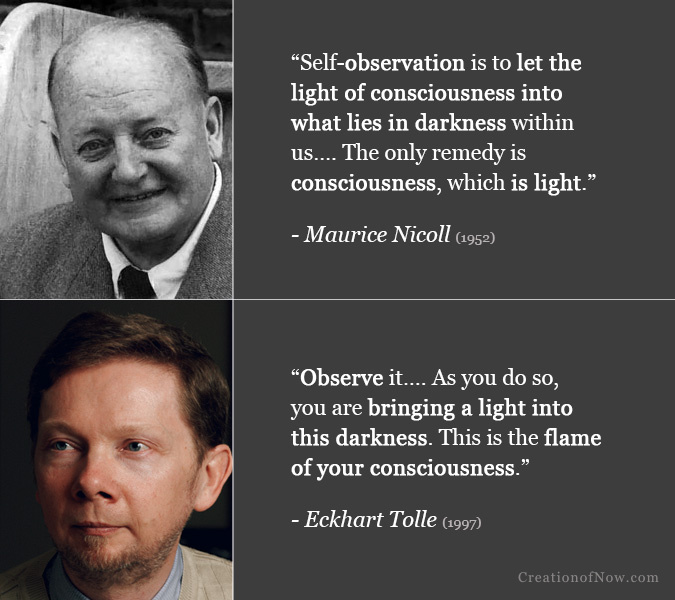
They describe how a person brings the light or flame of consciousness into their inner darkness through self-observation.
Read the article this image was featured in here.
The act of self-observation is said to cast a “ray” or “beam” of light into the psyche. Both Nicoll and Tolle identify this light as consciousness.
Read the article this image was featured in here.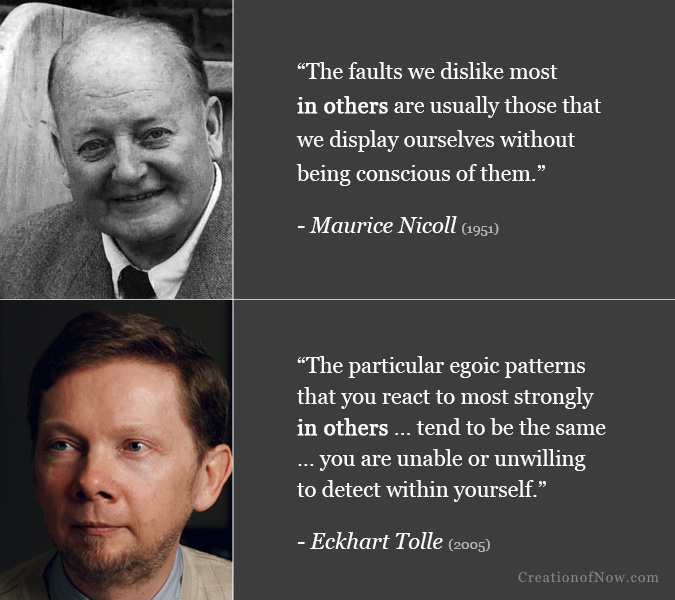
They reiterate the idea that the faults we dislike most in others may exist unrecognized in us.
Read the article this image was featured in here.
Nicoll, who was close to Jung, brought the idea of psychological projection into self-observation practice. Tolle continues in this vein.
Read the article this image was featured in here.
Nicoll and Tolle both state, in very similar terms, that those things we greatly criticise or resent in others are also present within us.
Read the article this image was featured in here.
They emphasise the importance of watching many aspects of one’s behaviour and inner states in the present moment.
Read the article this image was featured in here.
Both authors refer to the “power of self-observation” and indicate this capacity can be developed with practice.
Read the article this image was featured in here.
They describe self-observation as a process of directing attention inwards, to observe one’s thoughts, emotions and inner states in a detached way.
Read the article this image was featured in here.
Both Nicoll and Tolle write of bringing what is unconscious into the light of consciousness through self-observation.
Read the article this image was featured in here.
Directing “the light of consciousness” inwards through self-observation is the means for self-transformation in the work of Maurice Nicoll and Eckhart Tolle.
Read the article this image was featured in here.Quotes on Spiritual Psychology
These images come from articles comparing how Tolle and earlier authors discuss aspects of the psyche, such as the personality and essence.

Our “essence” is our deepest self, the real/true aspect of who we are, Nicoll and Tolle convey.
Read the article this image was featured in here.
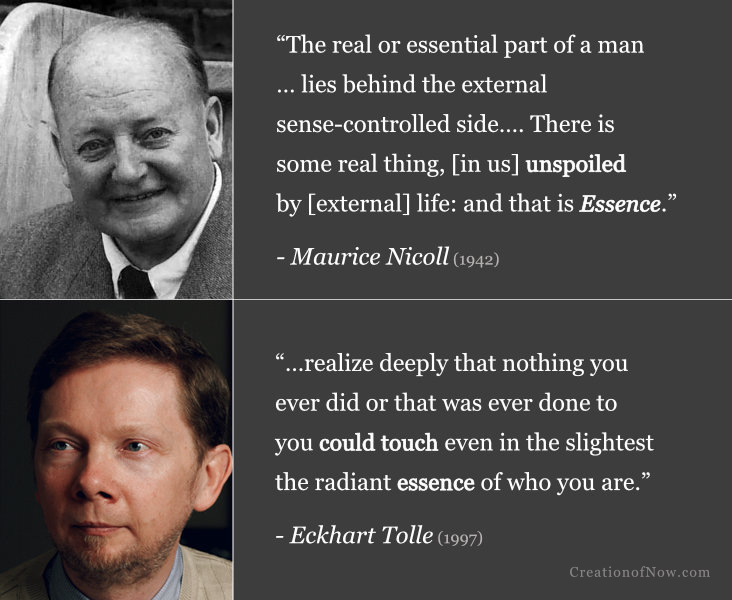
Essence remains untouched or unspoiled by what happens externally, they suggest.
Read the article this image was featured in here.

People identify more with their personality/psychological form and neglect essence, they say.
Read the article this image was featured in here.

What we consider our personality or refer to as “I” is not who we really are, they explain.
Read the article this image was featured in here.

Our personality, shaped by exterior customs or conditioning, isn’t really us, the authors say.
Read the article this image was featured in here.

People typically mistake their personality for who they really are, Nicoll and Tolle suggest.
Read the article this image was featured in here.
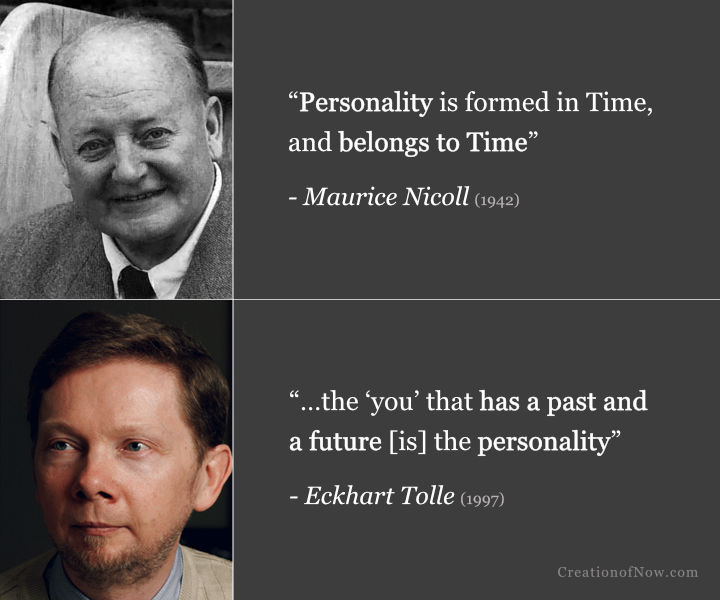
Nicoll and Tolle both characterise the personality as time-limited.
Read the article this image was featured in here.
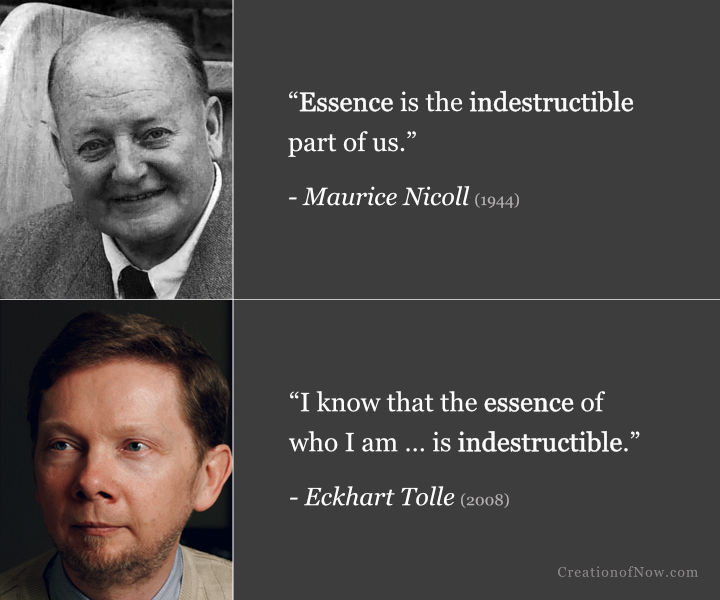
They describe our “essence” as eternal/timeless and “indestructible.”
Read the article this image was featured in here.

Our essence or true nature continues after death, the authors say, but the personality perishes.
Read the article this image was featured in here.
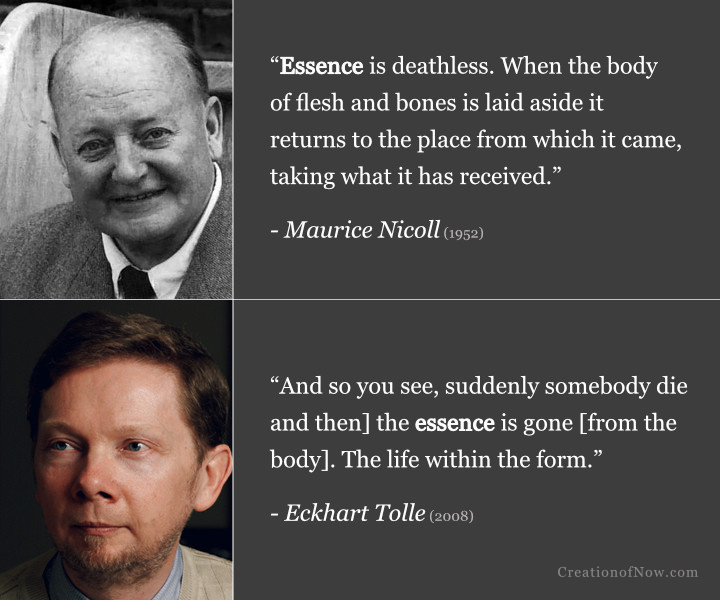
Essence isn’t bound to the body; it departs it at death and continues on, they suggest.
Read the article this image was featured in here.

Unlike the personality, one’s essence or true nature cannot be lost or stripped away, they say.
Read the article this image was featured in here.

Psychologically we’re typically trapped or imprisoned in the personality with all its fixed ways and prejudices, the authors convey.
Read the article this image was featured in here.
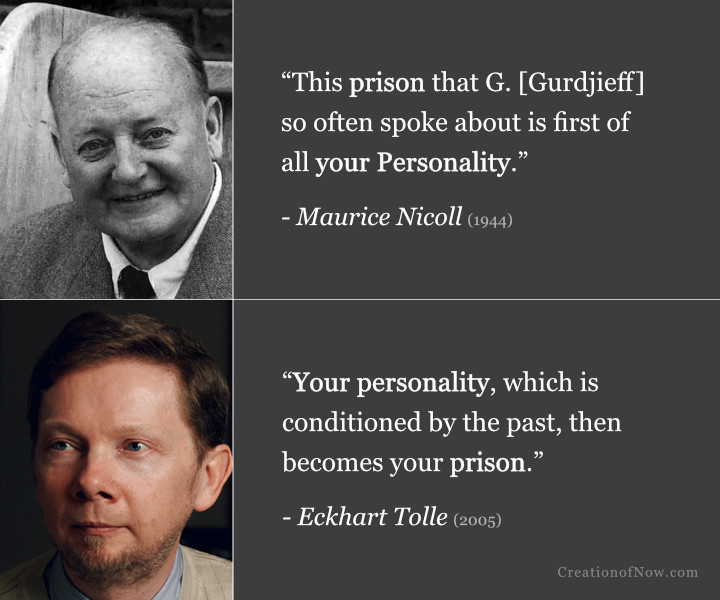
Both describe “your personality” as a “prison” as Gurdjieff did (although, unlike Nicoll, Tolle never directly mentions Gurdjieff or the Fourth Way in his writing).
Read the article this image was featured in here.

In a higher state of consciousness we feel something beyond time and the personality, Nicoll and Tolle convey.
Read the article this image was featured in here.

This state is found by being more conscious in the now, the authors insist. One momentarily transcends time and the personality and experiences their true self, which is eternal or timeless.
Read the article this image was featured in here.

It’s in the now, the state of being conscious in the present, where our real self is found, they maintain.
Read the article this image was featured in here.

The cross can represent the meeting of a “vertical” and a “horizontal” dimension, Nicoll and Tolle both say. Tolle acknowledges others have used this interpretation before, but gives no names.
Read the article this image was featured in here.
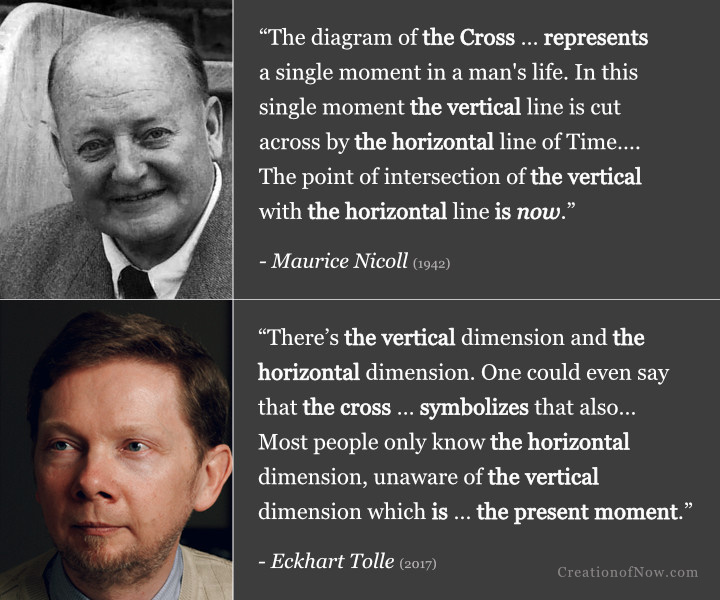
The vertical, the authors suggest, exists beyond the horizontal line of the cross depicting time. It’s only encountered in the present moment or now.
Read the article this image was featured in here.

The vertical pertains to our state of being, they convey, while the horizontal pertains to the events of our life in time.
Read the article this image was featured in here.

We only feel or enter the vertical by being conscious in the now, Nicoll and Tolle convey.
Read the article this image was featured in here.

The present moment is the entry point for the vertical dimension that’s beyond time, the authors tell us.
Read the article this image was featured in here.

We can consciously perceive eternity/the vertical dimension coming into the horizontal flow of time, we are told.
Read the article this image was featured in here.

We must consciously feel/focus on the now to experience the vertical dimension of eternity, they suggest.
Read the article this image was featured in here.

Our false self comes about through identifying with the mind or imagination, and gives us a false feeling/sense of who we are, Nicoll and Tolle convey.
Read the article this image was featured in here.

The false self/personality acts as a psychological substitute for our true or essential self, the authors say.
Read the article this image was featured in here.

The false self/personality is formed by the environmental/cultural influences/conditioning of our upbringing and the imaginary idea or image we form of ourselves, the authors convey.
Read the article this image was featured in here.

The egoic or imaginary self that rules us is a “mental construct” or “composed of imagination” Tolle and Nicoll respectively tell us.
Read the article this image was featured in here.

Our imaginary or illusory “I” or “self” is the cause of many misunderstandings or misinterpretations, creating confusion inwardly and externally.
Read the article this image was featured in here.

The false self is the source of much of the dysfunction or misunderstandings occurring in human relationships, the authors say.
Read the article this image was featured in here.
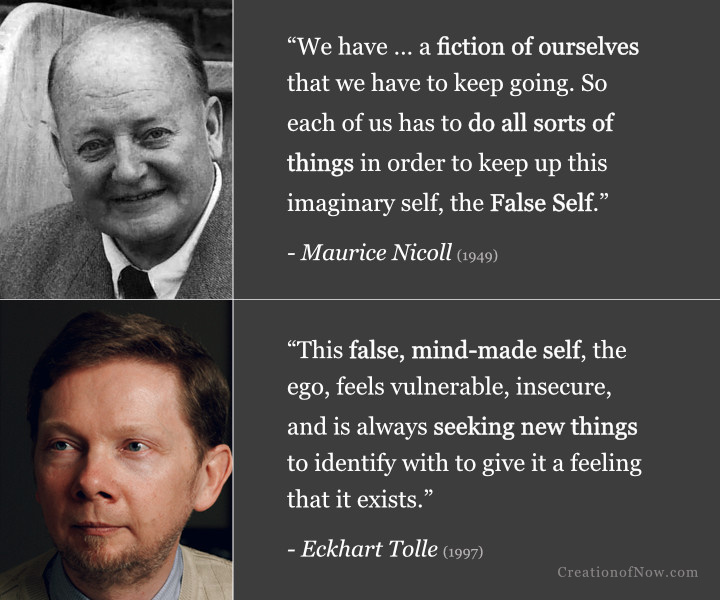
Because the false self is only a fiction/mind-made, we constantly feel compelled to do things to maintain it, we’re told.
Read the article this image was featured in here.

Living through the False Personality/ego creates underlying fear, the authors say, even if it’s hidden. Striving to maintain something unreal brings ongoing anxiety/insecurity about losing it.
Read the article this image was featured in here.

The desire to sustain the ego or false personality creates an unending psychological struggle or expense because one is essentially striving to maintain a fabrication, the authors suggest.
Read the article this image was featured in here.

The illusory or imaginary “I” or identity we cling to, and its fictitious self-image/pictures, will start to dissolve or collapse when brought into the light of consciousness, the authors say.
Read the article this image was featured in here.

We mistake the false self for who we are, the authors say, but when we observe or recognize what’s in us clearly, our illusory/imaginary self begins to dissolve.
Read the article this image was featured in here.

To release oneself or withdraw—psychologically—from one’s identification with the false self is a great relief, the authors suggest.
Read the article this image was featured in here.

The pseudo self or phantom self wants to fortify itself—the idea or image of who we think we are, Nicoll and Tolle say.
Read the article this image was featured in here.

The imaginary/illusory I or identity is at least partly sustained, Nicoll and Tolle suggest, by the erroneous importance or perception we give to “the word ‘I'”
Read the article this image was featured in here.

Nicoll and Tolle both explain that a person can discover the truth of who they are only by gradually identifying what they are not.
Read the article this image was featured in here.

Allowing one’s false sense of self to diminish—and thus become less or nothing in relation to what we thought we were—draws real “I” or Being to us, the authors suggest.
Read the article this image was featured in here.
Quotes on Negativity Within
These images come from articles comparing how Tolle and earlier authors discuss how negativity operates in the psyche and its detrimental effects.

Nicoll and Tolle both emphasize that each person is responsible for their own negative inner states, regardless of external situations or the actions of others.
Read the article this image was featured in here.

Emotional negativity is unnecessary / unnatural, they suggest, and detrimental to humanity.
Read the article this image was featured in here.
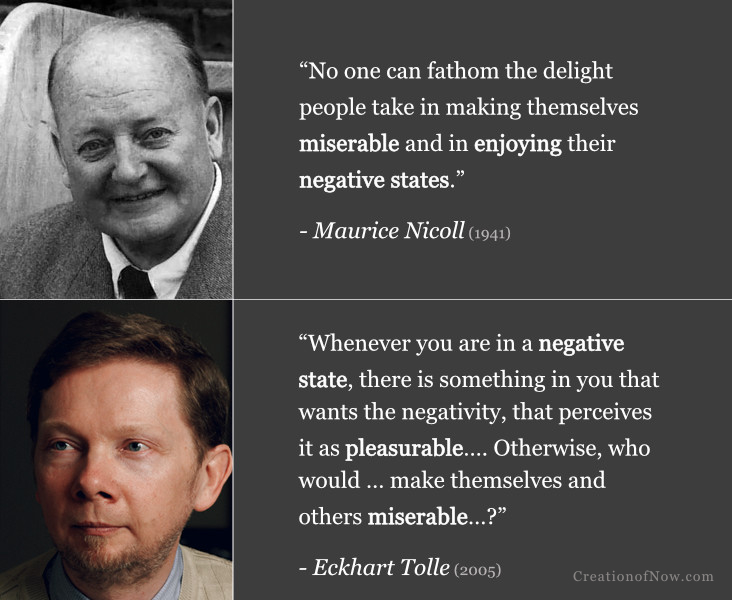
Both authors describe how people take enjoyment / pleasure out of negative states and being miserable.
Read the article this image was featured in here.

Our inner negativity is infectious or contagious, even more so than physical disease, Nicoll and Tolle both say.
Read the article this image was featured in here.
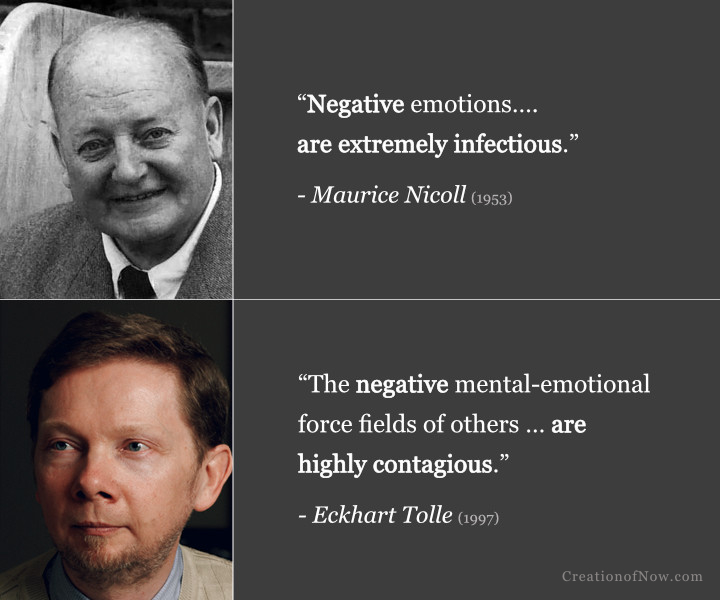
Both authors emphasise that negativity is infectious or contagious and can spread from person to person.
Read the article this image was featured in here.
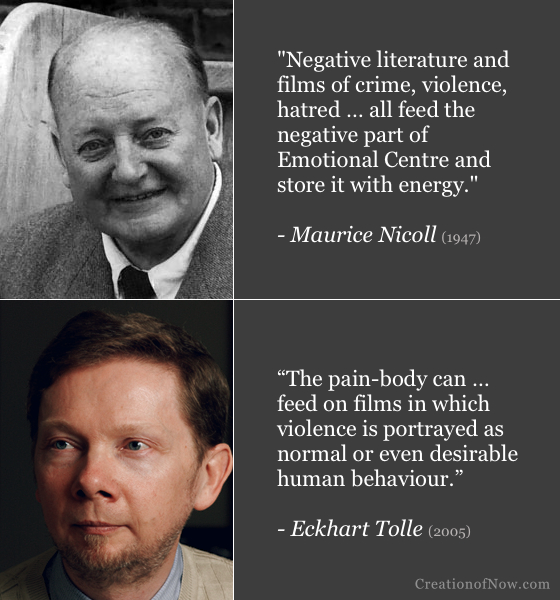
Both Nicoll and Tolle state that violent films can “feed” the negative part of the Emotional Center (Nicoll) or pain-body (Tolle).
Read the article this image was featured in here.

Nicoll and Tolle describe how negative or painful emotions are used as “food” or “energy” for the negative part of the emotional center or pain-body respectively.
Read the article this image was featured in here.

The negative emotions of parents will cause their child to accumulate negative emotions too. This then fosters the growth and development of a negative emotional part or pain-body in the child, according to Nicoll and Tolle.
Read the article this image was featured in here.

Both Barry Long and Tolle state that people have a parasitic entity living within, called the emotional body / pigmy (Long) or emotional pain-body (Tolle). Their description of this entity has numerous similarities, such as that it is made of energy, is cunning, does not want to be found out, has dormant and active periods, and can cause aches and pains in the body.
Read the article this image was featured in here.
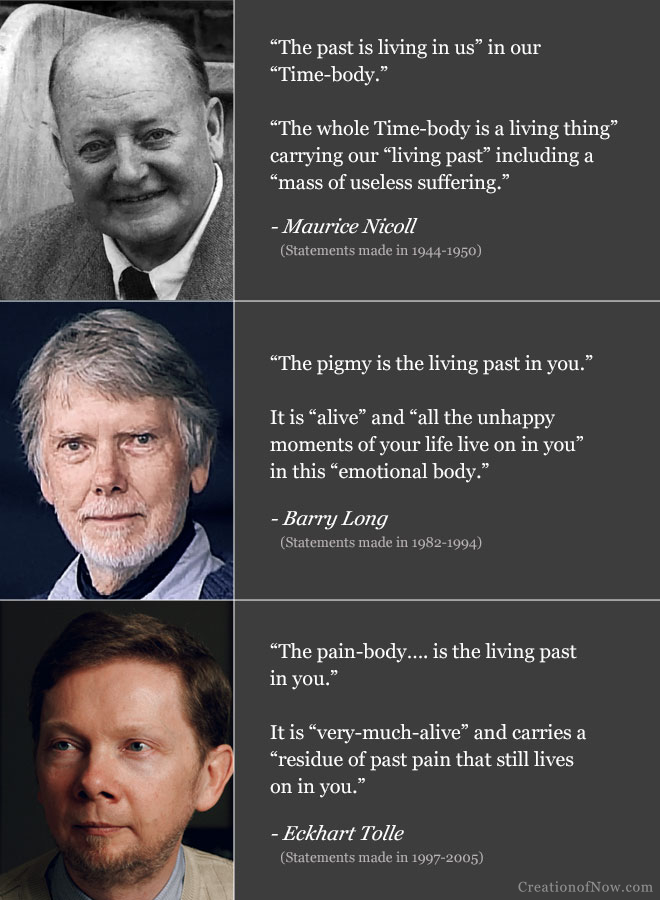
Nicoll, Long, and Tolle all state how past emotional pain or suffering continues to exist in people within the Time-body (Nicoll), pigmy (Long), or pain-body (Tolle). They all suggest this body is alive and carries the “living past” in us.
Read the article this image was featured in here.

When two people marry, they’re also said to marry each-other’s Time-bodies (Nicoll) or pain-bodies (Tolle).
Read the article this image was featured in here.

They both explain how the expression of negative emotions / negative energy triggers latent negativity in others as well.
Read the article this image was featured in here.

Nicoll and Tolle describe negativity as an inner poison or pollutant affecting ourselves and others.
Read the article this image was featured in here.

Nicoll and Tolle both direct readers to observe how negativity drains one’s force / vital energy.
Read the article this image was featured in here.

Nicoll and Tolle suggest that negative emotions disturb energy circulation within us, potentially leading to illness.
Read the article this image was featured in here.

They describe how negative thoughts or emotions drain energy from the body, which can cause illness / disease.
Read the article this image was featured in here.

Negativity can worsen a disease and cause it to persist or become chronic, the authors maintain. (“If you complain, feel self-pity, or resent being ill, your ego becomes stronger,” writes Tolle)
Read the article this image was featured in here.

Both indicate negative emotions can harm health and lower one’s resistance to illness.
Read the article this image was featured in here.

Both Nicoll and Tolle describe negativity as toxic to a person. They state it has effects not just on the psyche but also on the physical body.
Read the article this image was featured in here.

Nicoll and Tolle suggest negativity can express or manifest physically as a disorder or illness.
Read the article this image was featured in here.
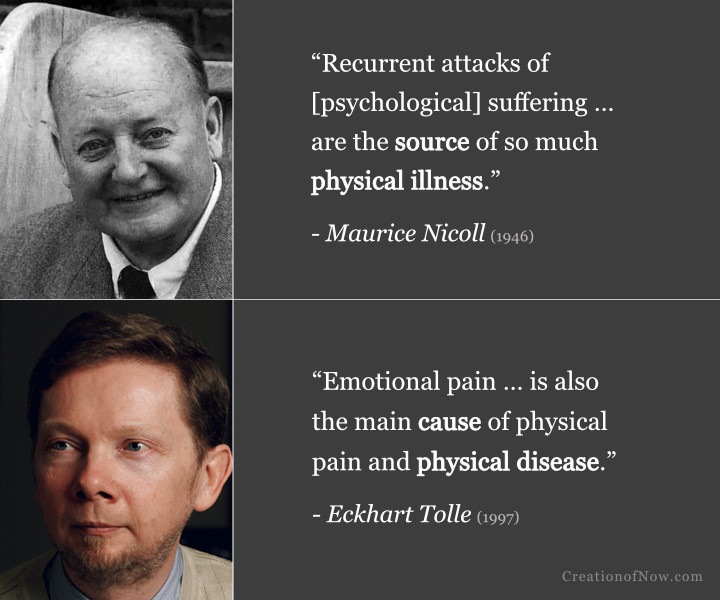
Both state that psychological pain and suffering can give rise to physical disease.
Read the article this image was featured in here.

Nicoll and Tolle both describe how grievances are often expressed inwardly as inner talking / compulsive thinking.
Read the article this image was featured in here.

Persistent negative trains of thought can be fueled by feeling unfairly treated by others or even God, they tell us.
Read the article this image was featured in here.

They highlight the importance of inner forgiveness for spiritual growth and connect this to Jesus’ teaching to forgive or make peace with your enemies.
Read the article this image was featured in here.

Nicoll and Tolle both state that a person’s smiling exterior can be a lie / façade hiding inner pain.
Read the article this image was featured in here.

Both authors describe how negativity accumulates over time beneath the surface, which can cause disproportionate emotional responses to external irritants or challenges.
Read the article this image was featured in here.
Quotes on the Law of Opposites
These images come from articles comparing how Nicoll and Tolle discuss the Law of Opposites.

You cannot have one emotion without experiencing its opposite, the authors explain, as emotions are subject to the law of opposites.
Read the article this image was featured in here.
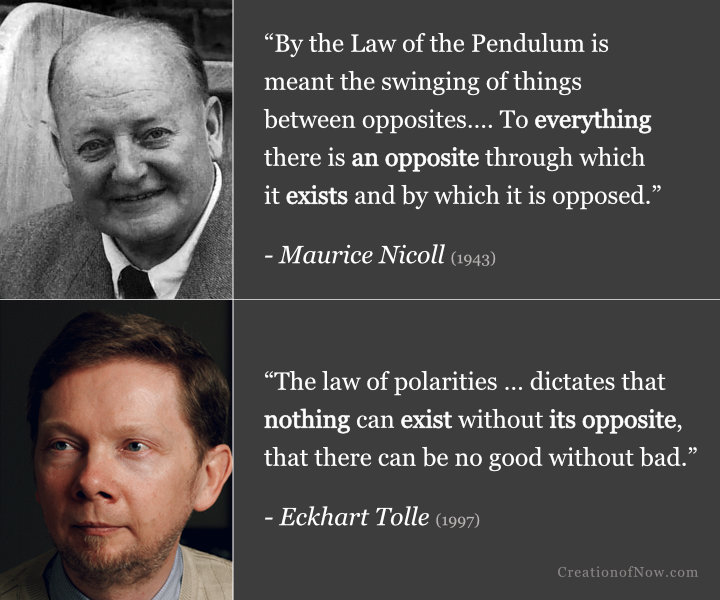
Everything in the universe has an opposite it cannot exist without, according to the law of the pendulum/polarities.
Read the article this image was featured in here.

The opposites of birth and death are fundamental to the manifest universe, and there are cycles between them, according the law of opposites.
Read the article this image was featured in here.

Cycles between opposite conditions occur on large and small scales: in the ascent and decline of nations, and in our own lives, Nicoll and Tolle say.
Read the article this image was featured in here.

The two opposite movements of expansion and contraction, occurring throughout life in various ways, is present in the beating of our heats, the authors tell us.
Read the article this image was featured in here.

Due to the law of opposites, there will be times when things go right and times when they go wrong for us, or cycles of gain and loss in our lives, Nicoll and Tolle suggest.
Read the article this image was featured in here.

We should not become despondent during the negative swing or cycles of this law upon us, but learn to use such times for inner growth, the authors suggest.
Read the article this image was featured in here.

Our ordinary thoughts and emotions function in opposites, according to this law.
Read the article this image was featured in here.
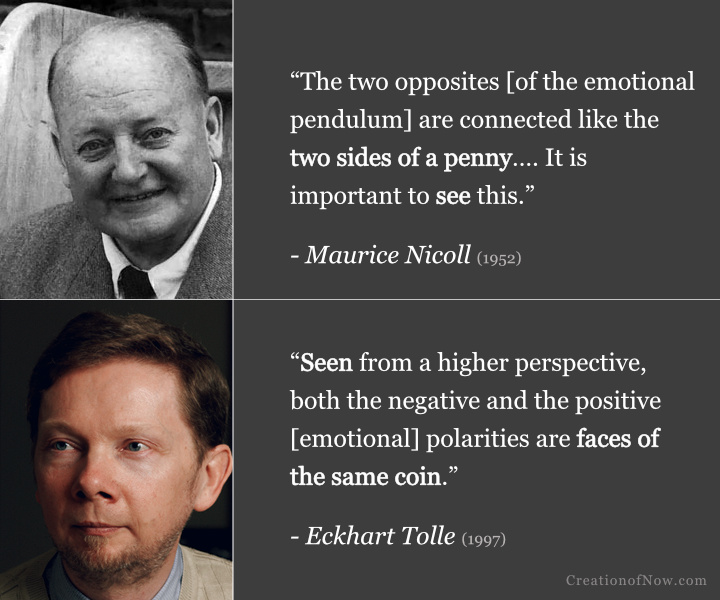
Opposite emotional states are really two sides of the same coin or penny, Nicoll and Tolle convey.
Read the article this image was featured in here.

When it comes to opposite states or emotions, “you cannot have one without the other,” the authors tell us, as they are inseparable.
Read the article this image was featured in here.

All our ordinary emotional states, like everything else in existence, will eventually turn into their opposite “in time” due to the action of the law of opposites, we are told.
Read the article this image was featured in here.
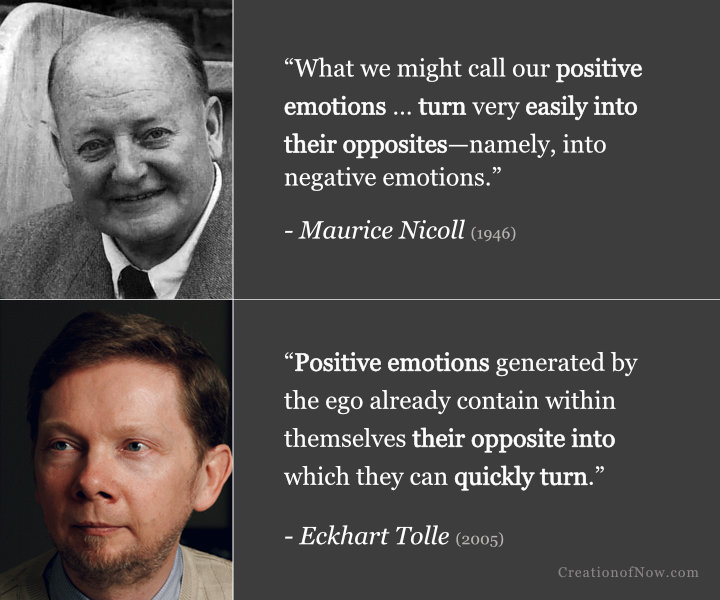
What we consider to be “positive emotions” can turn rapidly in their opposite, Nicoll and Tolle tell us.
Read the article this image was featured in here.

The emotion often called “love” is not true love, and can turn into hate in a moment/second, the authors convey. *Note: Nicoll is paraphrasing Ouspensky here.
Read the article this image was featured in here.
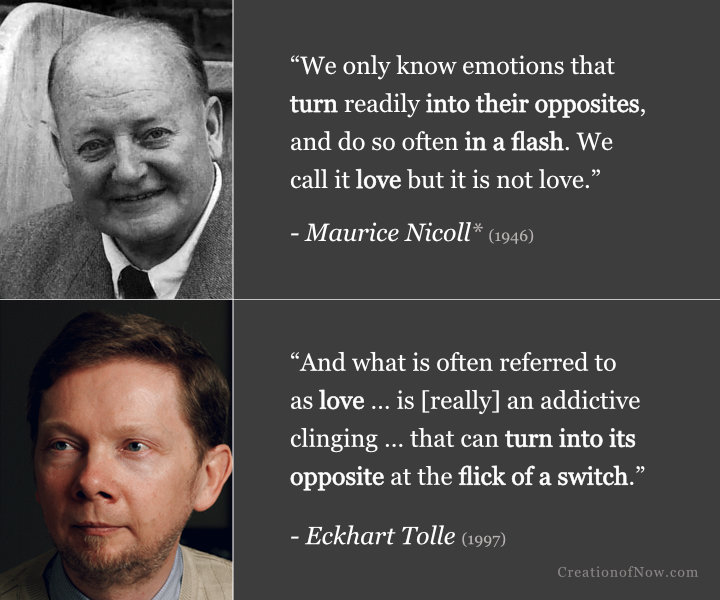
What we often regard as love can turn into its opposite “in a flash” or “at the flick of a switch” Nicoll and Tolle respectively say. *Note: Nicoll is paraphrasing Ouspensky here.
Read the article this image was featured in here.

Pleasant emotions or pseudo “love” can turn into something negative “in a flash” or “flick of a switch,” the authors respectively suggest.
Read the article this image was featured in here.

Praise or flattery can make us feel good, but the lack of it can make us feel bad, the authors say. This is an example of how ordinary emotions work in opposites.
Read the article this image was featured in here.

Because the unconscious emotional polarities are connected, so-called “love” is linked to hate, so love and hate often go together for many people.
Read the article this image was featured in here.

We stay psychologically trapped in swings or cycles between opposite mental-emotional states by identifying with our emotions, Nicoll and Tolle convey.
Read the article this image was featured in here.

If you identify with one polarity, or side of the pendulum, you will unconsciously perpetuate both it and the opposite side or polarity, the authors suggest.
Read the article this image was featured in here.

We can experience deeper or higher emotional states, different from the usual kind. These may disappear or be obscured, we are told, but exist beyond all typical opposites.
Read the article this image was featured in here.

Because higher or deeper emotions or states have no opposite, they can never become an opposite. Real love, unlike the pseudo kind, cannot turn into hate, Nicoll and Tolle say.
Read the article this image was featured in here.

Real love “has no opposite,” write Tolle and Nicoll, and brings a sense of “oneness” or being “as one.”
Read the article this image was featured in here.
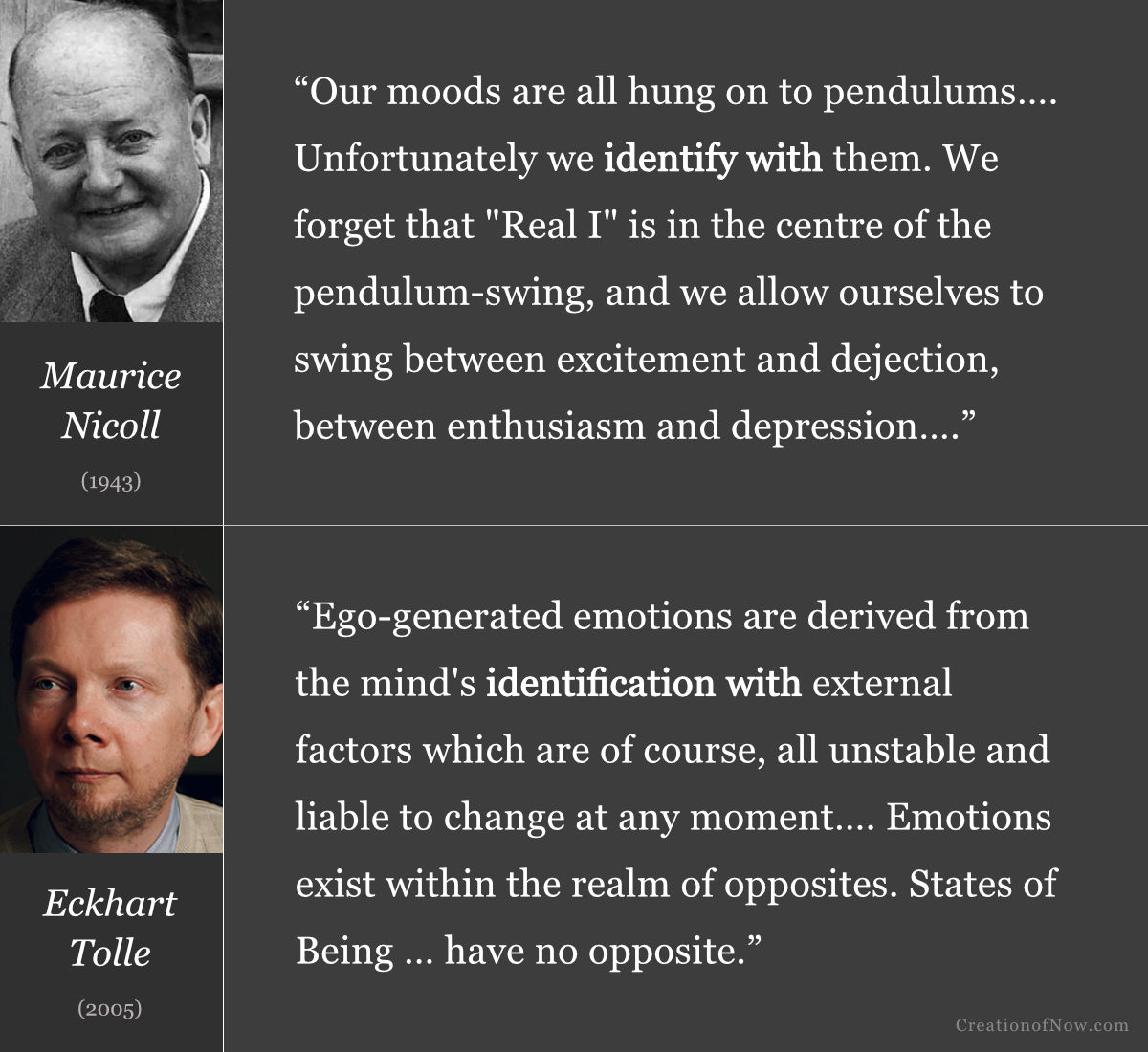
We identify with changing emotions and moods that swing between opposites, but our “Real I” or “Being” is not found in these cycles, the authors suggest.
Read the article this image was featured in here.

Our real self or Being cannot be reached or revealed in either emotional opposite, Nicoll and Tolle convey. It is beyond the opposites.
Read the article this image was featured in here.

Our real self or Being has no opposites, Nicoll and Tolle tell us.
Read the article this image was featured in here.

The happiness derived from attaining things isn’t deep, but the peace from one’s inner being is independent of anything else, and remains whatever happens—if you stay awake or present within, the authors convey.
Read the article this image was featured in here.
Identification | Psychological Projection
The False Self | Essence and Personality
The Now | Eckhart Tolle & Barry Long
The Time/Pain Body & Emotional Centre/Body
View main quote image categories:
Self-Observation | Spiritual Psychology
Negativity Within | Law of Opposites
